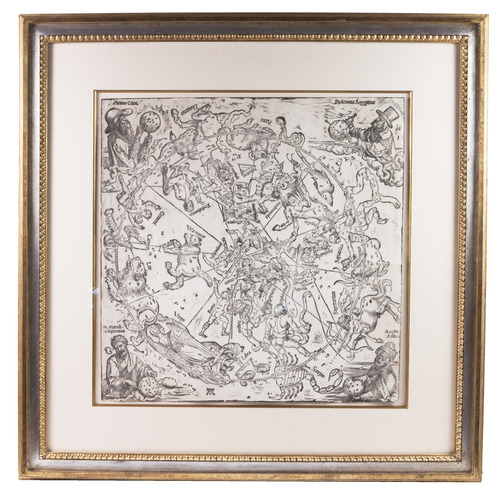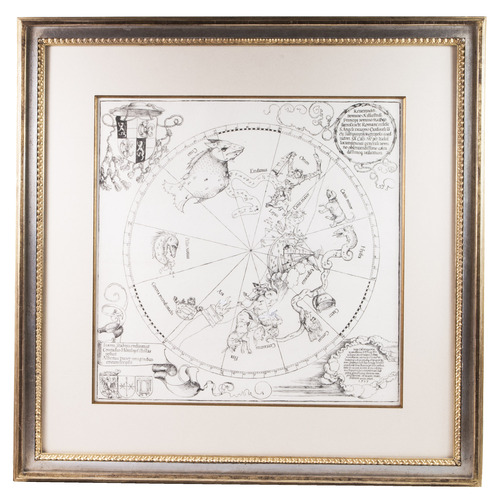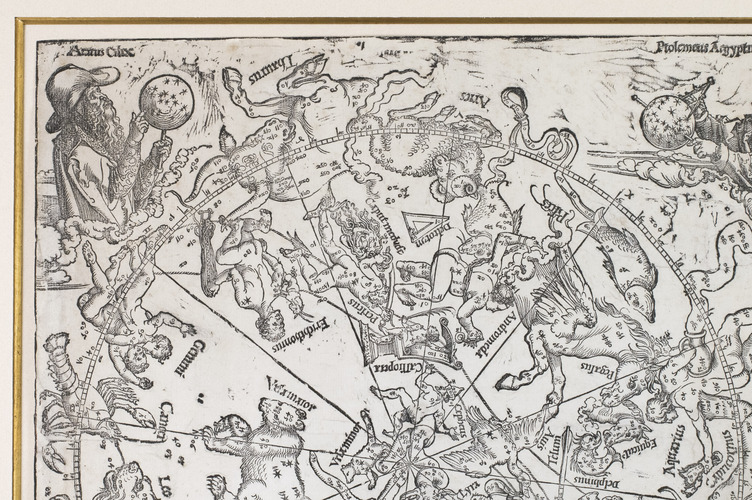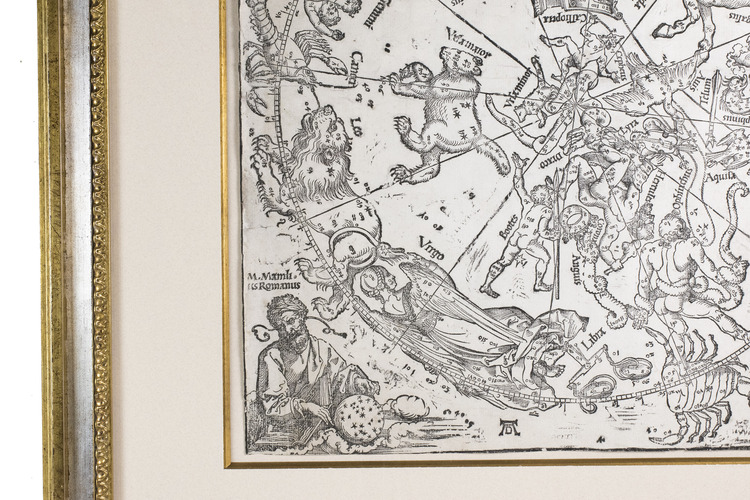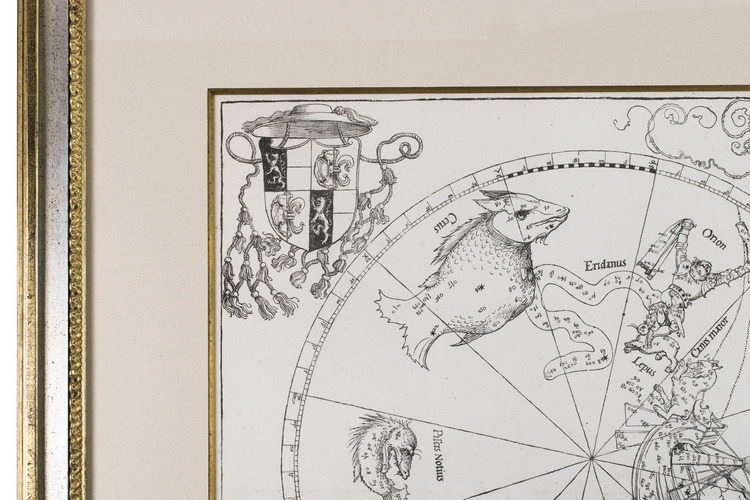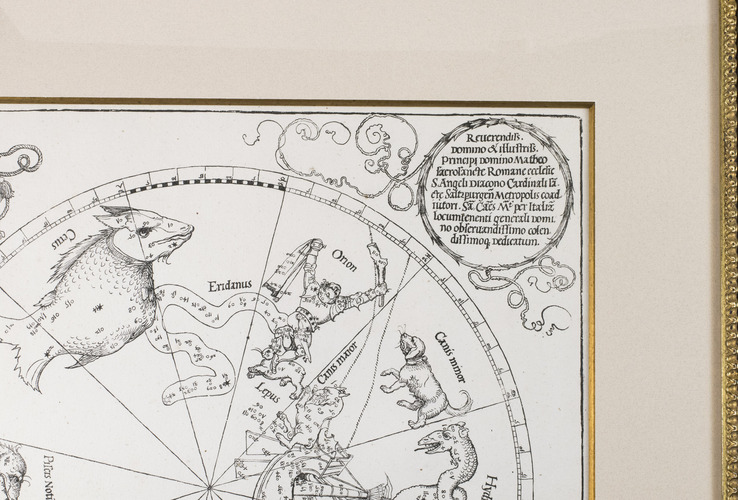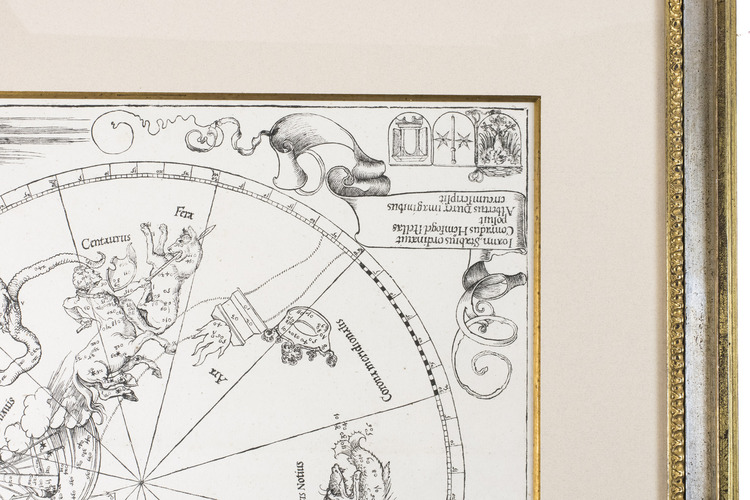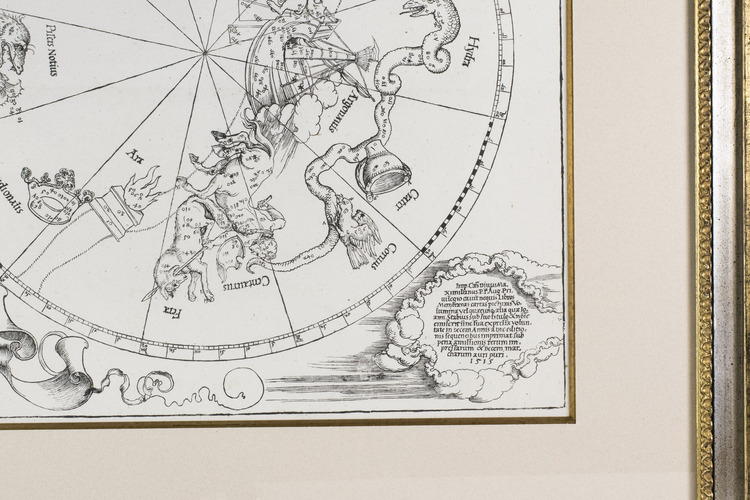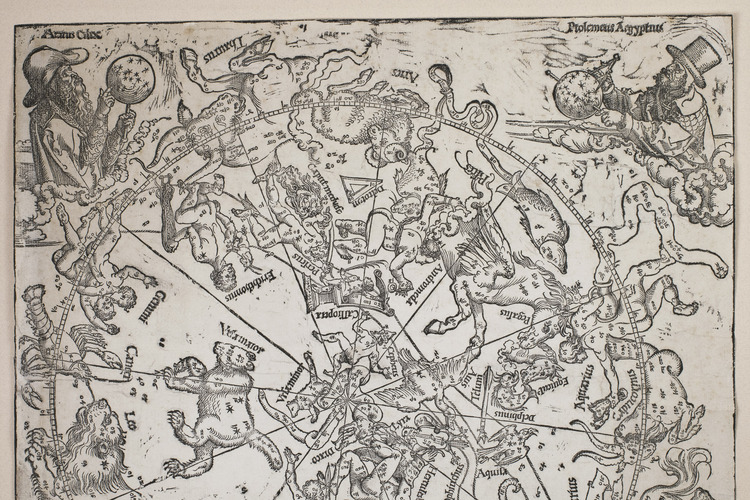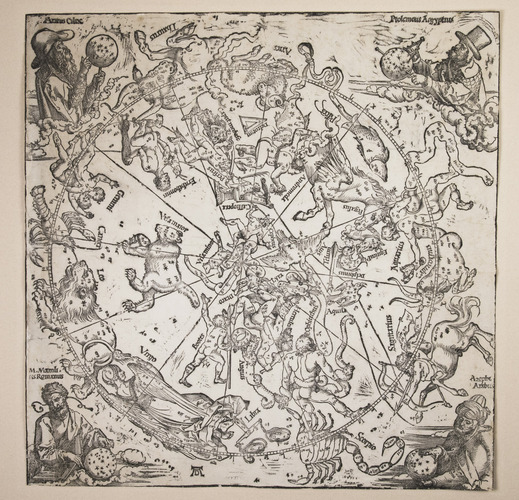DÜRER, Albrecht. [with Johannes STABIUS and Konrad HEINFOGEL].
[Imagines coeli septentrionales cum duodecim imaginibus zodiaci].
[ca. 1515].
With: (2) DÜRER, Albrecht, Johannes STABIUS, Konrad HEINFOGEL. [Imagines coeli meridionales].
Ralf Leopold von Retberg, 1867.
Ad 1: map and leaf size ca. 43.5 x 42.5 cm; ad 2: map 43 x 43 cm; leaf size ca. 50 x 50 cm. Ad 1: woodcut map of the northern hemisphere in its second state, with Dürer's monogram. The map depicts all known constellations in the northern hemisphere in great detail, resulting in an intricate map in which all constellations can be clearly identified upon close inspection. According to Ptolemaic tradition the twelve signs of the Zodiac are displayed on the northern hemisphere and are to be read counter-clockwise. That is, as seen from space, or as they would appear on a celestial globe. The constellation figures are therefore shown from their back view. Dürer decorated the four corners of the northern chart by portraits of four ancient authorities, dressed in their assumed national dress, each holding a celestial globe: Aratus representing the Greek, Ptolemy the Egyptian, Al-Dufi the Islamic, and Marcus Manilius the Roman tradition of astronomy. Ad 2: 19th-century lithograph facsimile of the map of the southern hemisphere in its second state. The map includes some cartouches and coats-of-arms providing information about the collaborators and patrons. In the upper corners is a dedication to Cardinal Mattheus Lang von Wellenberg and his arms. The lower right corner shows Stabius's privilege for publication, granted by Maximilian I. In the lower left are the coats of arms of the three authors and a printed badge noting their names and tasks: Johannes Stabius ordered (and edited), Konrad Heinfogel positioned the stars, Albertus Durer drew the images. The celestial map itself depicts the stars and figures of the then-known 15 constellations in of the southern hemisphere. Large areas of this map are vacant of constellations because they were not visible from the Mediterranean or Middle East, the area where the sources of Ptolemy's Almagest came from. Although the discoveries of the new world produced new observations of the southern firmament, these were not incorporated.
Both maps are mounted matching gold-coloured frames (67.5 x 67.5 cm), in white passe-partouts with a gilt line directly framing the maps on the inside of the passe-partouts.
€ 750,000
Extremely rare first edition of Dürer's celebrated celestial map of the northern hemisphere, here in the second state (with Dürer's monogram, see Meder), together with a rare, limited edition 19th-century lithograph reprint of Dürer's celestial map of the southern hemisphere. The Imagines coeli septentrionales and Imagines coeli meridionales are the first ever printed scientifically rigorous star charts, combining accurately calculated star-placement with classical constellation figures. Dürer's planispheres included a coordinate system and attempted to accurately position the stars of the 48 constellations based on the star catalogue contained in Ptolemy's 2nd century CE Almagest.
"These two celestial planispheres can be seen as a representation of over two thousand years of intellectual thought. The constellation and celestial iconography inherited from Antiquity, Greek geometrical studies, and the Islamic scholarship focusing on spatial accuracy for charting the heavens all culminated in this work, aided by the aesthetic mastery of Dürer." (Wörz, p. 156). The ancient tradition of making celestial maps can be traced back, by way of Arabic sources, to classical ones. These first printed star charts derive from an Arabic type that depicted each hemisphere separately. Dürer decorated the four corners of the northern chart with portraits of four ancient authorities, dressed in their assumed national dress, each holding a celestial globe: Aratus (of Soli in Cilicia) Cilex (315-245 BCE) author of the astronomical poem Phaenomena, Azophi Arabus or Abd al-Rahman al-Sufi (903-986 CE), an Arab astronomer, Ptolemy Egyptus (ca. 90-168 CE) the Islamic and Marcus Manilius from Syria (1st century CE) a Roman astrologer and author of a book of constellation lore called Astronomica. It was the Arab astronomer Ἁbd al-Raḥmân al-Ṣûfî who produced a revised and updated version of the star catalogue in Ptolemys Almagest called the Book of the Fixed Stars (in Arabic, Kitâb al-Kawâkib al-Thâbita) around 964 CE. From the tenth century onwards, the translated works of Ptolemy were reintroduced into Europe by Islamic Arab exchanges. There they were re-translated from Arabic into Latin. So it is through this roundabout route of old Greek writings being transmitted through Arabic hands and then translated back into Latin in Europe in the middle ages that we have ended up with a polyglot system of Greek constellations with Latin names containing stars with a mixture of Arabic and Greek titles.
There are only 11 examples of the original 1515 charts in institutions worldwide (Amsterdam, Berlin, Coburg, Dresden, National Maritime Museum London, Melbourne, Munich, Nuremberg, Paris (2 copies) and Schweinfurt).
Albrecht Dürer (1471-1528) was a German painter, printmaker, and theorist of the German Renaissance. He created the first printed European star charts, collaborating with Johannes Stabius and Conrad Heinfogel. The work showed the classical zodiac of forty-eight constellations - with the addition of the Caput Medese - based on the Almagest by Claudius Ptolemaeus. It was hugely influential, and a version was used by Peter Apian in his great work Astronomicum Caesarum. Johannes Stabius (after 1460-1522) was professor of mathematics in Vienna. Since 1503, he served as court historian and academic adviser to Maximilian I. In this function he forwarded several imperial commissions to Dürer. Konrad Heinforgel (born 1517) was a German astronomer and mathematician.
Ralph Leopold von Retberg (1812-1885), German hereditary lord in Wettbergen near Hanover, was a painter, art and cultural historian, heraldist, numismatist, mineralogist, and poet. He brought together an extensive collection of rare prints, especially by Albrecht Dürer, and created his own limited edition of 25 lithographic copies based on Dürer's woodcuts, which he passed on to collector friends. Ad 1: Meder 260.2; WorldCat 556858092, 46223852 (2 copies); ad 2: cf. Meder 259.2; general information: Patrick Hunt: Albrecht Dürers 1515 Imagines Coeli Star Charts (Electrum Magazine, July 20, 2012); Wörz, Adèle Lorraine, The Visualization of Perspective Systems and Iconology in Dürer's Cartographic Works, Oregon 2007 (Electronic dissertation: Permanent citation URL: http://hdl.handle.net/1957/3785).
Related Subjects:













